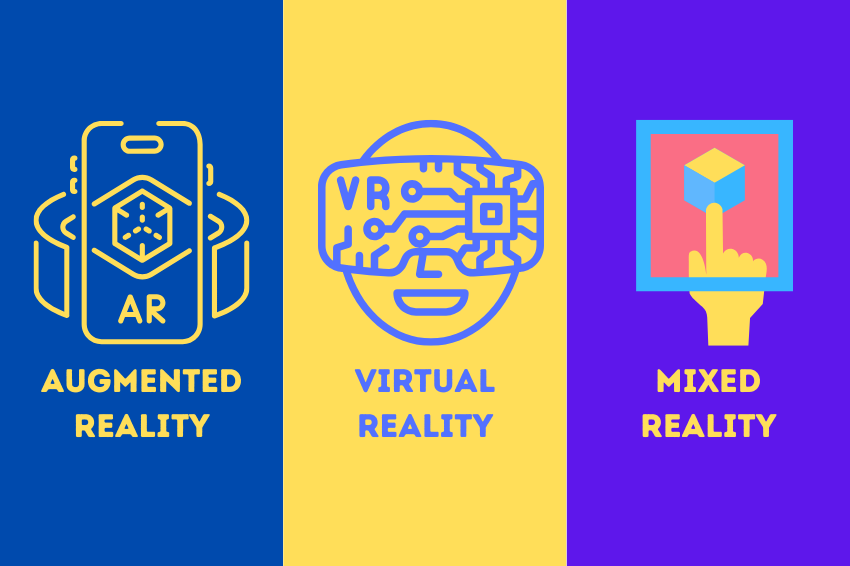Introduction to AR, VR and MR
Imagine if you could choose your reality; which would it be? Which would you prefer—the complete escape of a virtual world, the improved awareness of your immediate environment, or the smooth fusion of the two? The tectonic plates of reality may be realigning, and you may be feeling the faint tremors of our world changing as AR, VR, and MR start to alter our perception. It is not a glitch; it is the future, and we are here to help you map it out.

Let the numbers do the talking:
- A BCG and Mordor Intelligence survey estimates that the AR/VR/MR market is currently worth about $30.7 billion and is expected to reach $300 billion globally by 2024.
- According to an IDC report, $4.1 billion will be spent on AR, VR, and MR training.
- According to IDC, the global market for AR/VR headsets grew by 92.1% in 2021, with 11.2 million units shipped on a global scale.
These metaverse market numbers are quite amazing. With AR, VR, and MR technologies, the metaverse is expanding at a never-before-seen pace. With several important countries leading the way in terms of invention and use. When we are developing cutting-edge applications, sophisticated infrastructure, and progressive legal frameworks to support advances in technology, nations are consistently expanding the realm of what is feasible in the metaverse.
These countries consistently push the limits of what is feasible in the metaverse by developing cutting-edge applications, sophisticated infrastructure, and progressive legislation that promotes digital innovation.
Defining AR, VR, and MR
We are living through a change in how we engage with information, with one another, and with reality. As we enter the metaverse, the digital and physical worlds combine to form a more complex and nuanced sensory tapestry. The possibilities are, quite literally, boundless. Technologies such as AR (augmented reality), VR (virtual reality), and MR (mixed reality) have seen a rapid increase in popularity. Though there are more branches to the metaverse, we will focus on these three types of technology, their use cases, and how they differ in a similar ecosystem.
Augmented Reality
This is the most basic and common kind of technology that includes the overlapping of digital reality over real-life experiences. This can be done through a phone or a head-worn device, such as glasses or a headset. Let’s look at some of its use cases of augmented reality:
- Features like 3D navigation, sensor monitoring, driving directions, and visuals of terrains are all a part of AR technology that is helping transportation take it to a different level.
- Consumers can now purchase goods over popular e-commerce sites by actually viewing them in hyper realistic settings, like getting a 360-degree overview of the product. AR has taken a deep dive into mobile commerce and visual merchandising.
- AR can now provide visual prosthetics in the healthcare industry. Researchers and doctors are now willing to perform difficult surgeries and operations with the use of AR technology.
Virtual Reality
By immersing the user in a virtual environment, you can create realistic experiences, whether they are imaginative or realistic scenarios. In AR, reality is extended by an extra layer of information, but in VR, this is not the case. It involves stepping out of reality and entering a different universe through virtual reality glasses. It uses a combination of hardware and software to create a realistic 3D environment. Let’s look at some of its use cases:
- In virtual reality gaming, computer games are set in a three-dimensional (3D) artificial environment. Virtual reality environments are created using VR software and presented to the user in such a way that they replace the real-world environment, causing suspension of disbelief and allowing the user to experience the VR environment as real.
- VR is primarily used in the healthcare industry. Virtual reality allows medical professionals to interact with 3D models of patient anatomy, simulated surgical procedures, and therapeutic settings using headsets, motion controllers, and haptic feedback.
- It is common in architectural contexts as well. Architects have been using 2D blueprints to design buildings for decades. Many architecture firms now own VR headsets, such as the Google Cardboard or the Meta Quest, thanks to some fantastic advancements in both hardware and software. Plans are transformed into 3D digital models using design software such as Revit and Rhino. Architects can enter spaces they have designed in just a few minutes, thanks to programs like Enscape and Twinmotion.
Mixed Reality
When one has an optimal combination of augmented and virtual reality, it comes down to mixed reality. It’s like touching virtual reality through innovative headsets and glasses. For instance, with the Meta Quest application, these headsets will immerse you in a virtual environment while remaining in the physical world.
Since MR encompasses both VR and AR, it is crucial to remember that different proportions of each technology can be combined to create an MR experience. Let’s look at some of the use cases of mixed reality:
- Students can interact with virtual objects in a variety of mixed-reality educational applications. Teachers can use 3D simulations and projections to teach students remotely. Medical students at Case Western Reserve University in Ohio were taught anatomy using the Microsoft HoloLens.
- Mixed reality allows employees from any company to work together with clients or coworkers even if they are not in the same place. Applications that translate languages in real time could be used to easily get around language barriers.
- In the Cave Automatic Virtual Environment (CAVE), a person is surrounded by screens that are projected onto them from above and below. In order to enhance the projections, users can experience a sense of perspective that mimics the real world with 3D glasses and surround sound.
What once appeared futuristic is now a part of our everyday lives. Let us look at real-world classifications of AR, VR, and MR that you may already be using.
AR, VR, and MR: Key Differences
Now that we have covered the fundamental concepts underlying metaverse technologies, let us look at some of the key differences between AR, VR, and MR.
| Feature | Augmented Reality (AR) | Virtual Reality (VR) | Mixed Reality (MR) |
|---|---|---|---|
| Definition | Enhances the real world with digital elements | Creates a fully immersive digital environment | Blends real and virtual worlds interactively |
| Environment | Real world with overlaid virtual content | Fully virtual, replacing the real world | Merges real and digital worlds, allowing interaction |
| Device Examples | Smartphones, AR glasses (e.g., HoloLens, Magic Leap) | VR headsets (e.g., Oculus Quest, HTC Vive, PlayStation VR) | HoloLens 2, Magic Leap 2, Meta Quest Pro |
| User Interaction | Limited interaction with digital elements | Fully interactive in a virtual space | Real-time interaction with virtual objects in a real environment |
| Real-World Integration | Adds virtual objects to reality but doesn’t fully merge | Completely replaces the real world with a virtual one | Digital and real-world objects interact seamlessly |
| Immersion Level | Low to moderate | High (fully immersive) | High (real & virtual elements co-exist dynamically) |
| Example Applications | Pokémon GO, Google ARCore, IKEA Place | VR gaming, VR simulations, virtual tourism | Industrial design, remote collaboration, medical training |
According to a report, industry statistics show that metaverse technologies are anticipated to grow tremendously in the years to come. Experts are saying that the number of users in the metaverse will rise to 2.6 billion by 2030.
Such high rates, which are predicted to start at 17.4% in 2025 and more than double to a significant 39.7% by 2030, further demonstrate this impressive growth trajectory. This data points not only to show how Metaverse technologies are gaining attraction, but they also show how this new digital frontier has the potential to fundamentally change how billions of people will engage with digital material, communicate, and collaborate.
It’s critical to understand the underlying moral and societal ramifications of the apparent differences between AR, VR, and MR as we continue to work with increasingly realistic technology.
Ethical Considerations: AR vs. VR vs. MR
VR, AR, and MR have a significant impact on people and society. With the use of these metaverse technologies, people can journey to these hyper realistic worlds, which offer immersive learning experiences and even mental health therapy.
Important problems concerning how VR and AR impact human behavior are also brought up by their immersive qualities. Long-term usage of virtual environments will cause the lines between virtuality and reality to become increasingly hazy, which may affect interactions and perceptions in the real world.
Every technology that individuals are exposed to in today’s environment has an impact that is more psychological than physical. No one can escape the digital world, and it is like being constantly watched. So, let us discuss some of the gravest modern-day issues.
Augmented Reality
Privacy Issues
Privacy is one of the main perceived risks associated with augmented reality. AR technologies can see what a user is doing, which puts their privacy at risk. It gathers a great deal of data about the user’s identity and activities.
Misinformation & Deepfakes
By immersing their image in fictitious augmented reality scenarios, numerous celebrities and well-known figures have been deepfakes. In addition to this, fake news has been a trend that damages the reputation of any company or person.
Advertising & Manipulation
AR ads can be harsh and very much intrusive, as they can target any set of audiences from any real-world locations.
Virtual Reality
Psychological Impact
Users are becoming addicted to such technologies, and their screen time is increasing, causing them to become detached from reality. This plays a significant role in users’ emotional desensitization. The widespread use of such technologies has resulted in mental numbness, stress disorders, depression, anxiety, and other issues.
Data privacy and tracking
The motion sensors in VR headsets are all fixed on human motions. They are aware of where you are, what you are doing, what you would prefer to do, and even what you might not enjoy. Because the network is automated and connected to the cloud, such constant tracking and loss of data privacy are a warning sign for its users and a growing advantage for unethical hackers.
Harassment in Virtual Spaces
Increased cyberbullying and online stalking are serious issues, as are deepfake images that pose cyber threats.
Mixed Reality
Blurred Reality Boundaries
MR makes it more difficult to tell what is virtual and what is real, which could be manipulated. In contrast to AR, which merely positions static digital objects in the real world, MR anchors digital elements in physical space, giving them the appearance of being there.
AI Bias in MR Systems
Businesses could utilize this information to produce highly customized ads that take advantage of vulnerabilities and unintentional responses. This might result in deceptive advertising strategies that compromise the autonomy of the consumer.
Government and Corporate Surveillance
MR data could be used by governments to monitor the movements, social interactions, and even emotional states of their citizens. This might have a chilling effect on the right to free speech and assembly. There is significant concern about the possibility of social scoring systems in which people are assessed and punished according to their actions in MR environments.
Thus, there are fundamental and sophisticated differences between AR, VR, and MR, as we have covered. And now is the time to bind everything together.
Conclusion: Embracing the Future of Immersive Technology
Even though AR, VR, and MR seem to be interchangeable to us, rest assured that the blog post above has covered some of the most fundamental and sophisticated distinctions between these technologies. The very fabric of human-computer interaction is being handled by this technological integration, opening up previously unheard-of possibilities for interaction and experience.
Our everyday interactions with the physical world are improved by augmented reality’s sophisticated overlay of digital information onto real-world settings, while virtual reality’s highly immersive digital environments immerse users in fully simulated worlds.
In the meantime, mixed reality’s inventive combination of virtual and real-world elements produces a smooth transition that creates completely new opportunities for both creative expression and useful applications. Each of these technologies adds unique benefits and capabilities to the larger XR ecosystem, creating a diverse array of interactive opportunities.
Nathan Johnson is a seasoned content writer with seven years of experience specializing in technology and digital marketing. His expertise lies in crafting insightful, SEO-driven content that helps businesses strengthen their online presence and connect with their target audience. Nathan has contributed to various industry-leading blogs, offering valuable perspectives on emerging trends, best practices, and innovative strategies in digital marketing and tech.





